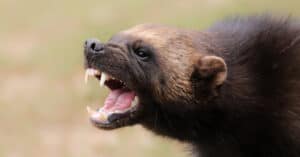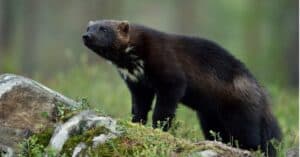Wolverine and Black Panther may be two of the most popular characters and dangerous fighters in the Marvel comic book universe, but their real-world equivalents are just as worthy of praise. Both panthers and wolverines have a reputation for being fearsome predators in their native environments, but there’s a lot more to the story than the popular impression about them can properly convey. The fact that they occupy separate continents entirely means they’ll never have the chance to square off in the wild, it begs the question of which would win in a fight. We can use the thorough scientific knowledge about each type of animal to see how they’d fare in a hypothetical showdown between a wolverine and black panther. Let’s start with the stats.
| Wolverine | Black Panther | |
|---|---|---|
| Weight | 20 – 70 lbs | 125 – 250 lbs |
| Length | 25 – 40 in | 40 – 70 in |
| Top Speed | 20 MPH | 50 MPH |
| Bite Strength | 50 PSI | 200 PSI |
| Lifespan | 5 – 13 years | 8 – 10 years |
Black Panther vs. Wolverine: The Fundamentals
“Wolverine” is a ferocious name to assign to the world’s largest weasel — but these are still some shockingly fierce creatures. Despite being located throughout North America, wolverine populations are most abundant in Canada. As an omnivore, the wolverine can adapt the amount of meat in its diet to suit its environmental conditions. They aren’t afraid to scavenge after larger predators either. The wolverine is notable for its aggressive demeanor which is backed up by claws, jaws, and fangs that need to be powerful enough to tear through frozen bone, sinew, and meat. Wolverines serve as apex predators in many communities, though they’re preyed on by wolves, bears, and mountain lions where territories intersect.
The colloquial term “black panther” refers to members of either the jaguar or leopard family that display monochromatic black coats. Despite living on multiple separate continents — including the Americas, Africa, and Asia — these cats have similar enough builds, hunting techniques, and characteristics to make them comparable in this fight. No matter which environment these cats live in, they are always the apex predators within their ecosystem. As befitting their coats, these solitary and nocturnal cats rely on a combination of stealth, tactics, and raw power to bring down their prey. Their ability to climb trees means that they can strike from above, often without ever being noticed.
Wolverine vs. Black Panther: Hunting Techniques
Black panthers hunt at night not just because it gives them cover to blend into their surroundings, but also because their black coats tend to absorb a lot of heat in the tropical climes they occupy. As solitary predators who expend a lot of energy, a single hunt could spell the difference between life and death for the jaguar. As a result, they tend to be strategic about minimizing the amount of energy they expend. Rather than run their prey down to the point of exhaustion, they’ll get as close as possible and close the gap. And unlike most big cats, they bite down right into the back of the skull rather than the neck. They’re known to eat practically anything in their environment, even if that means facing down imposing animals like the quarter-ton tapir or crunching through the shells of large turtles.
While jaguars hunt some pretty big prey, they’ve got nothing on the wolverine. A single wolverine can take down a reindeer that can be ten times its size or more, and they’ve been known to effectively protect their meals from both bears and wolves. That said, they also tend to target smaller prey like rabbits and frogs.
Both the hearing and the sight of the wolverine is poor by any metric, but they manage to be effective hunters on their prodigious sense of smell alone. But they’re just as likely to scavenge for dinner, and their propensity for picking at the meals left behind by wolves can quickly turn bloody. Despite their reputation for being aggressive, they’re surprisingly stealthy hunters who are especially well known for their ability to elude traps. When taking down larger prey, wolverines will take advantage of their frozen environments to store the carcasses for later.
Black Panther vs. Wolverine: Size and Reach
Unfortunately for the wolverine, the black panther is working with a serious size advantage. The average black panther is twice the size of the average wolverine and many times heavier. In fact, it’s the third heaviest big cat in the world just behind tigers and lions. Despite that, the jaguar is still nimble. Whereas many other hunters harry their prey until they’re worn out, the top speed of 50 miles per hour is enough to close in on prey and get the killing blow quick. By contrast, a wolverine can only move at about half the speed, but they’re capable of moving quickly under stealth.
Wolverine vs. Black Panther: Natural Weapons
While the fangs and claws of the black panther and wolverine may vary in terms of size, each animal uses them for similar purposes. The retractable claws of the black panther allow it to climb trees capably, but they also help provide traction when sprinting. The claws aren’t a primary source of disabling prey, but it does allow them to hold a firm grip while delivering the killing blow with their jaws. Non-retractable wolverine claws are sharp, but they aren’t used primarily as weapons. Instead, they use their claws to dig burrows and hide frozen meat — and they can also be used to climb trees, albeit not with the deftness of a black panther.
Wolverines are popularly believed to have some of the strongest jaws in the animal kingdom, but the anecdotes don’t quite match up to the facts. A black panther demonstrates four times the raw crushing power with their jaws, but wolverines are still capable of crunching through frozen bone. Often, the most dangerous part of a wolverine’s bite isn’t the force, however. A frequent tactic is to use their sharp and powerful jaws to sever the prey’s spinal column so they can be killed at the wolverine’s leisure.
Black Panther vs. Wolverine: The Showdown
In a fair fight to the death with all other things being equal, it’s hard to imagine a scenario where the black panther doesn’t win. The speed, strength, and power of this animal make it hard for the much smaller wolverine to handle. While the wolverine is a relatively stealthy animal, jaguars are capable ambush hunters — and they have the additional advantage of being able to stalk treetop canopies.
That said, there are far too many variables to reach a conclusion with certainty. The black panther and wolverine are designed to excel in their ecosystems — tropical jungle and frozen tundra respectively — and either would struggle to adapt to the other’s. The home-court advantage is real in both cases. Moreover, it’s rare that animals fight to the death, and wolverines are known for taking down prey many times their size and fending off ferocious predators like mountain lions and bears. The most likely result of a fight between the two is a situation where one flees.
Fortunately, the world separates these two and they do live in vastly different habitats so a showdown is not likely to happen. Both of these consummate predators face obstacles to their survival that they have to fight each day. They don’t need to add any more.
Up Next
- 10 Incredible Panther Facts Check out his article if you would like to learn more about these beautiful, deadly predators.
- 11 Amazing Wolverine Animal Facts Wolverines are elusive but fearsome and tough predators. Find out more about them in this article.
- Types of Jaguar Cats are jaguars and panthers the same? Learn more about these big cats here.
The photo featured at the top of this post is ©
FAQs (Frequently Asked Questions)
Who would win in black panther vs. wolverine?
It would be an uphill battle for the wolverine considering that black panthers are significantly stronger and larger than wolverines with stronger jaws. But these animals occupy two very different ecological niches, and the winner would largely be predicated on the terms of the fight.
Thank you for reading! Have some feedback for us? Contact the AZ Animals editorial team.






